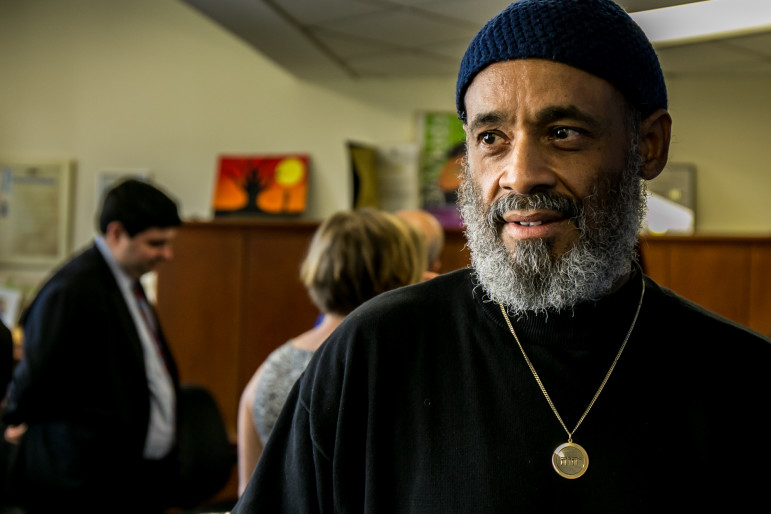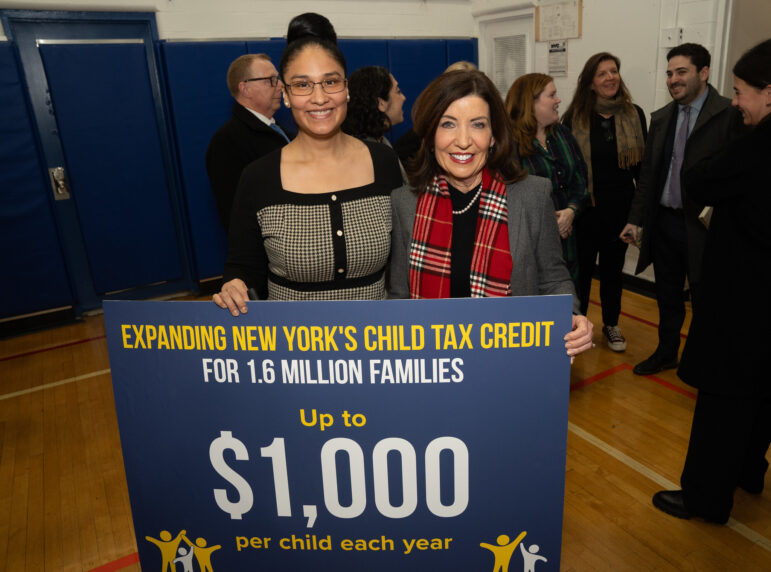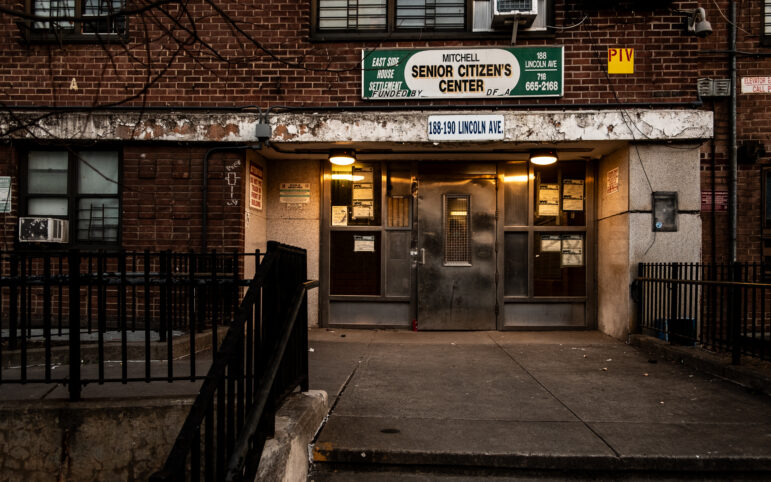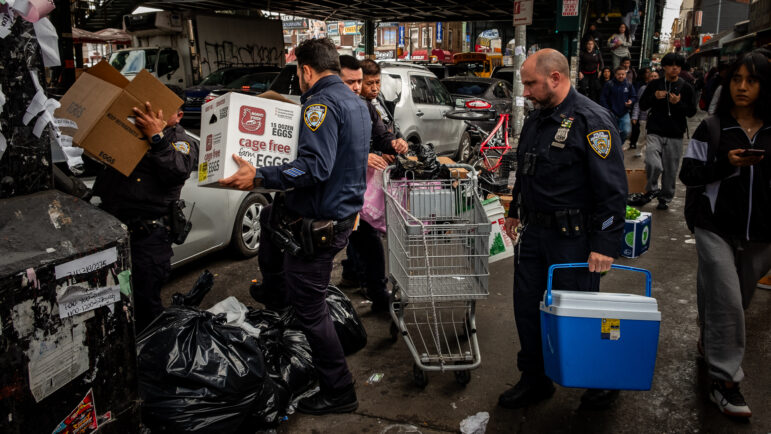
Adi Talwar
Phillipe Hogarth, a homeowner in Queens, is relieved his property was removed from the tax lien sale.
After Phillipe Hogarth’s mother passed away in 2007, Hogarth moved with his wife and children back to his childhood home in Cambria Heights, Queens. He was proud to raise his kids in the house where he had grown up in the 1970s.
But with Hogarth homeschooling his two sons, and his wife, a therapist for autistic youth, employed through sporadic contracts, the family struggled to pay the house’s rising property taxes, and this February their address appeared on the city’s 90-day tax lien sales list.
Since 1996, the city has collected tax debt by giving delinquent property owners 90 days to pay their balance, get on a payment plan or prove they qualify for an exemption. If owners fail to comply, their debt is sold to a private trust, which hires servicers to collect the debt while charging the owner 9 percent interest rates (or higher, for certain classes of properties) and exacting other fees. Since 2007, the Department of Environmental Protection has also sold liens on unpaid water and sewer charges for all building types except single-family homes.
It’s a system that works well to pressure owners to pay up: On average, 80 percent of the properties on the 90-day list make arrangements and get their liens removed from the sale. (The city also issues a 10-day list and a five-day list as the sale approaches.) As a result of this policy, the rate of delinquent property taxes has fallen from an average of 4.4 percent in the early 1990s to 1.4 percent in FY 2014. And it’s good for the city’s finances, too: With delinquency rates down and income generated by the sales to the trust, the city has recovered a total of more than a $1.3 billion in revenue since 1996.
But for Hogarth, his $2,400 in overdue property taxes and $3000 in water debt had suddenly become a source of intense stress. Because his parents had not placed Hogarth’s name on the deed, the city told him he couldn’t qualify for a payment plan and would have to pay the entire charge up front. Hogarth said city staff also said his water debt would be sold to the trust, despite the fact that he owned a one-family home.
Hogarth knew that if he didn’t get his address off the sales list by May 12, his debt could balloon out of control. A study of the 2014 tax lien sale by the Center for New York City Neighborhoods found one homeowner with arrears of $4,467. A year after their tax lien was sold to the trust, their debt had grown to $8,836.
“I do believe that low-income people should not have to pay so much,” says Hogarth. “You can’t squeeze water out of a rock.”
The Legal Aid Society took up Hogarth’s case and argued that as an heir, he did qualify for a payment plan. Luckily, Hogarth managed to negotiate a payment plan with the city just in time to avoid this week’s lean sale. But many homeowners will not be as fortunate: the city’s five-day sales list still included 11,461 buildings. Many of these buildings are small, one-to-four family homes concentrated in low-income neighborhoods with high percentages of people of color—places like East Brooklyn, Staten Island’s North Shore, Southwest Queens and the Northeast Bronx, according to maps of properties on the 10-day list for this week’s sale.
As the tax-lien sale system approaches its 20th anniversary, a growing number of advocates and policymakers are questioning whether the policy’s economic benefit is worth its cost to low-income homeowners. And, in light of the city’s unprecedented affordable housing crisis, they’re wondering whether the city could leverage its power over tax delinquent properties more creatively, as a means to preserve affordability in buildings with unstable finances.
At a press conference this morning, public advocate Letitia James called on the city to exclude water and sewer debt from the lien sale for low and middle-income owner occupants of one-to-three homes. There were 4,398 such properties on the 10-day water-lien sale list.
“The water lien sale…disproportionately hurts our middle and low income residents and can result in high fees, large debt and put many in foreclosure,” said James. “Every homeowner has the responsibility to pay their bills and taxes but the punishment for late payment should not be the loss of your home.”
She also urged the city to increase its efforts to inform owners about payment plans and how to qualify for exemptions, to create a “Homeowner Advocate” position who would help homeowners navigate among the multiple agencies involved in the tax lien sale, and to clarify rules to ensure that even if a resident is an heir without a deed or shares ownership of the deed with others, they can qualify for assistance programs.
Last but not least, James said nonprofits and houses of worship should be excluded from both the water lien sale and the property tax lien sale. (Nonprofits are exempt from paying property taxes, and the Department of Finance does try to remove nonprofits that end up on the list erroneously, but some unidentified properties owned by nonprofits still end up in the sale each year)
James is not the only one demanding reform: in a February report, Comptroller Scott Stringer called on the city to remove underutilized, vacant and repeatedly tax delinquent properties from the tax lien sale. The report suggests the city should foreclose on such properties and put them in a “land bank” to develop as affordable housing.
Behind these elected officials stand 26 affordable housing and legal organizations called the Coalition for Affordable Homes who have called for exemptions of a variety of other types of properties from the lien sale, including owner-occupied homes, vacant land and multifamily buildings.
“There is a legitimate public policy question,” says Caroline Nagy of the Center for New York City Neighborhoods, a member of the coalition. “Should homeowners who are already in financial distress have to face such large increases in their debt in such a relatively short period of time? Is it important that the servicers and the investors and the trust can see so much return?”
A City Council task force on tax liens was established last year to consider reforms to the system, but a press spokesman for Council member Donovan Richards said that the task force has focused mostly on how to help homeowners get off this year’s list. With reauthorization of the policy required at the end of this year, it is yet to be seen whether City Council will renew the policy in its current form.
An era of privatization
When the city adopted the tax lien sale policy in 1996, it was putting an end to an era in which it had played an elephantine role as a conveyor and manager of a large abandoned housing stock, all at great cost to itself.
In 1976, in the midst of a fiscal crisis and desperate to increase revenue, the city passed a law that allowed it to foreclose on any property delinquent on its taxes for more than a year. Rather than pay up, however, thousands of landlords simply abandoned their buildings, leaving the city with 100,000 apartments in its portfolio. The city worked with community groups and a growing nonprofit affordable housing sector to rehabilitate these buildings, but the task was not cheap: A 1995 study by the Department of Housing Preservation and Development (HPD) found that on average, when the city seized a property for $36,000 of unpaid property taxes, it ended up spending $2.2 million to rehabilitate and transfer that property to a new owner.
In the 1990s, as real estate investors began to eye New York and the costs of maintaining the city-owned building stock continued to rise, the Giuliani administration saw an opportunity to decrease the government’s role in housing rehabilitation while increasing city revenue. The city began selling the debt of owners owing more than a threshold amount of property taxes—for one-to-three family homes, a debt of $1,000 for three years. The tax liens were sold to a trust managed by the Bank of New York Mellon and funded by private investors.
Some classes of people are exempted from the sales, including low-income senior and disabled homeowners, veterans, those on active military duty, and owners receiving funds for rehabilitation from Hurricane Sandy. In addition, buildings with particular circumstances, such as those with extreme housing deterioration and severe tax distress, are removed from the sale, with some foreclosed on and transferred to nonprofit ownership through the Third Party Transfer program. This ensures the city controls the fate of buildings that need special treatment. In addition, the city boosts the value of the liens sold to the trust by removing the properties least likely to pay back their texts.
According to a report by the Citizens Housing and Planning Council, from 1996 to 2008, a total of 22,263 tax delinquent properties—or 15 percent of the total—were excluded from the tax lien sale, of which 2,295 entered foreclosure, with 436 completing foreclosure and moving to the Third Party Transfer program. Thereafter there were no tax foreclosures until 2015, when the de Blasio administration foreclosed on 370 properties, some of which may be transferred to the Third Party Transfer program in 2017, according to HPD and the comptroller’s February report.
Reauthorizations of the lien program since 1996 have made adjustments. In 2011, the City Council introduced new protections for homeowners, including lowering the amount of interest that the trust could charge on properties valued at less than $250,000 from 18 percent to 9 percent, introducing 10-year payment plans and raising from $1,000 to $2,000 the amount of delinquent water debt that places properties on the tax-lien sales list.
Questions of affordability
Critics of the system say it undermines housing affordability in two crucial ways. First, it saddles low-income homeowners with debt they cannot afford to pay. Second, it prevents community groups and affordable housing nonprofits from getting first dibs on abandoned properties.
“Imagine if you’re a single family homeowner in Queens and you’ve lost your job and you’ve fallen behind on your taxes,” says CUNY Professor John Krinsky. “Your only choice is actually to try to sell.”
Not only does the homeowner—and their tenants, if they have any— get displaced; the owner often loses the house for less than it’s worth. What’s more, the subject of a lien-sale can become a target for predators.
“These people are very vulnerable and now their addresses have been published,” says Nagy. “They owe a lot of money that they likely cannot pay and that creates a situation where they’re very vulnerable to being scammed or getting a bad deal.”
If the owner remains in delinquency, the trust can also choose to foreclose on the home: More than 800 of the properties sold in the 2014 lien sale—fully a third of the total—had foreclosure notices against them within a year, according to research by Center for New York City Neighborhoods. (A number of these buildings will likely avert foreclosure by paying their bills or selling their buildings; so far only 45 properties were foreclosed upon from the 2010 tax lien sale and 86 from the 2008 tax lien sale, according to the comptroller’s February report.) When these properties are foreclosed, they are often auctioned off to speculators with little interest in keeping the properties affordable.
And critics complain that the new system, while reducing costs for the city, makes it more difficult for nonprofit affordable housing developers and local community groups to gain access to abandoned buildings and lots.
“The practical effect for the nonprofit, community-based housing groups is that the supply of available housing has almost thoroughly evaporated,” says Krinsky.
A litany of proposals
The Coalition for Affordable Homes has numerous ideas about how to change the tax-lien sale, from tweaks to systemic overhaul. At the least, says Braun-Friedman of the Legal Aid Society, the city should increase the notification period to more than 90 days, ramp up outreach efforts to ensure qualifying homeowners obtain exemptions, introduce new payment plans tailored for low-income homeowners, further decrease the trust’s interest rates, and, as advocated by the Public Advocate this morning, create a citywide “homeowner advocate.”
Going further, the Coalition wants to exempt more properties from the tax lien sale, including vacant land, which advocates say could be purposed toward community uses, and one to three family homes, especially those owned by low-income owner-occupants. Multifamily rentals with predatory landlords should also be excluded, says Cea Weaver of UHAB, so the city can “use the outstanding tax debt as leverage to put the landlord into a regulatory agreement.”
Instead of going through the tax lien sale, these properties would be processed through an alternative system like the Third Party Transfer system, where they would still be given a chance to pay their tax arrears. In those cases when an owner cannot pay, the city would work out an arrangement to keep the house permanently affordable, such as by transferring the ownership of the house to a nonprofit, in which the owner remains a tenant.
Many ideas remain on the table for what this system could be like and how radically it should be transformed: One advocate proposed creating a new entity called a preservation trust, while Scott Stringer envisions a “land bank.” Advocates also see an opportunity to expand the purposes of the recently launched Community Restoration Fund, created by City Council to purchase distressed mortgages to assist homeowners in neighborhoods hardest hit by the foreclosure crisis.
Removing properties from the tax-lien sale will certainly cost the city tax revenue, but it is unclear how much. No one knows how many properties in the annual sale belong to low-income owner-occupants. As for vacant properties, from 2013 and 2015 about 4 percent of the tax liens sold were both persistently underutilized and tax delinquent, according to data from the comptroller’s report. The report argues that taking vacant properties from the sale list won’t be a serious cost to the city because owners of vacant properties are less likely than other property owners to pay their tax liens quickly: Over 57 percent of vacant properties foreclosed on in 2011 have still not made any payments, as of February.
Asked whether the city would support advocates’ recommendations to reform the tax lien sale, Sonia Alleyne, a spokesperson from the Department of Finance, said that while the agency is always open to advocates’ ideas, policy changes would need to move through a legislative process before the agency could comment.
She added that the agency works diligently to help homeowners get off the list, sending out four notifications and helping low-income homeowners who are unable to pay upfront to sign up for affordable payment plans. Many people end up on the lien sale list, she said, because they ignore these notifications.










3 thoughts on “Criticism Mounts as City Holds Another Round of Tax-Lien Sales”
Why Do the Boroughs only sell their tax liens to big fund companies instead of holding a public auction the way Nassau county does? With a public auction the interest is typically bid down very low, so homeowners have to pay less to redeem their lien. Also I would like to point out that selling a tax lien on the property is better than the alternative. In many counties in New York where they do not sell liens on the property, the property is simply sold at auction to pay the back taxes. This happens in most counties in NY.
this is stupid if you actually OWN the house you have some equity and should be able to get a heloc or some small personal secured loan….geez….either that or he is in hock up to his neck and needs to go back renting.
Pingback: "Stopping Foreclosure Rescue Scams in Their Track" and other headlines from 2016 - Center for New York City Neighborhoods